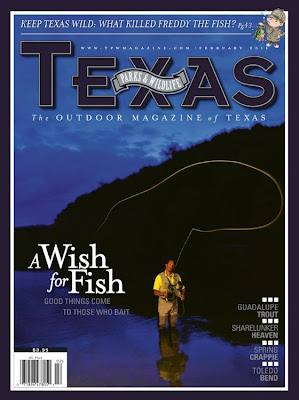
One of my favorite things in this world is mailbox photography money! Recently, one of the magazines we submit stock images to upon their request is a wonderful little pub called Texas Parks & Wildlife Magazine. The love to use images big and the design of the magazine is really nice. In February, they wisely chose the above image which was originally shot for National Geographic Adventure Magazine. A lighting package I’ve used since the mid 90’s that Joe McNally made himself famous for was chosen for this shoot.
To start with, my camera white balance was set on tungsten. Some of you are asking why would a photographer do that when shooting outside? Isn’t tungsten used for indoors? Normally yes! However, the color temperature reaction is a heavy shift blue. Add underexposing a stop and you end up with what you see in the background. This part of the river is pretty shallow with deep channels running through it so my Nikon flashes were attached to stands and placed in the river with us. Since my camera was set for tungsten light, a CT Orange conversion gel was needed to convert the daylight balanced light coming from the flash to a tungsten balance so the flashes light photographed white.
Finally, one flash was used to light the subject and it was placed about the 140 degree mark. For me, that scrapping light/angle of incidence is what I was going for, which helped illuminate the fly line whipping in the air as it is being cast. So, with the shutter, I controlled the exposure of the background and with the aperture I controlled the exposure of the flash. This is called dragging the shutter. At 100 ISO, I shot at 1/3 of a second @ F 5.6.
Ansel Adams always talked about seeing the image first in your minds eye and then shooting it. Most of us know that shooting the image is only half the job. Superior darkroom skills also are required to finalize the photo as you saw it originally in your minds eye! That said, for this image, the photo needed very little darkroom work. The sky was burned down a little to achieve that rich looking blue. You can learn more about my lighting techniques via my photography workshops or one on one mentoring programs.

No comments:
Post a Comment